meeting
Skipping Out
11/06/14 10:44
It has been awhile since I posted here; you have probably figured out that the allure of Twitter has grabbed me by the collar (wait, I almost never wear anything with a collar...) and at least some of the ideas that I would put here are ending up @wareslab instead. I’ve been surprisingly enthused by what you can find that way. Unlike Facebook, where you are strictly following certain “channels”, Twitter has many broadcasters who are providing information about a particular theme and that theme can cross quickly across users whether you follow them or not. In this way, despite being 5 hours from the nearest ocean to put my feet in, I am regaining connection with some of the intertidal nerds that I love so dearly (or more importantly, the beasts they study).
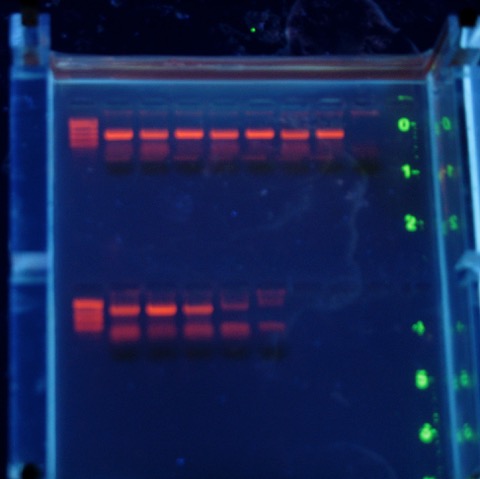
(which reminds me, I didn’t post any of the great pictures I took when in the intertidal just south of Coquimbo at Toloralillo; see chitons above, and Katie with a porcelain crab below) Edit: not sure why the chitons are not showing up, and an old picture of an agarose gel in their place. Such is technology some days. I’ll fix it later.
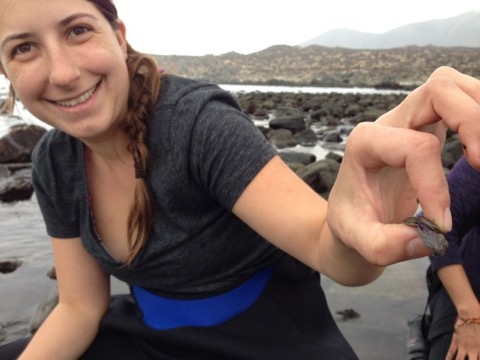
It’s a good thing to find such connections, even 140 characters at a time. Unfortunately I’ll be missing some genuine in-person connections next week when the #Evol2014 (Evolution) meetings take place in Raleigh, NC. This is generally one of my favorite meetings each summer, primarily for the good connections I’ve made over the nearly 20 years I’ve been a biologist. But, I went last year and gave a reasonable update on my work, saw many people, and this year I have personal (fun) conflicts - choices have to be made. So, keep me posted with the latest from your lab, and if you get a chance (though I think only 3 people read this, none of whom are attending the SSE meeting....) I recommend adding these talks to your slate!

(which reminds me, I didn’t post any of the great pictures I took when in the intertidal just south of Coquimbo at Toloralillo; see chitons above, and Katie with a porcelain crab below) Edit: not sure why the chitons are not showing up, and an old picture of an agarose gel in their place. Such is technology some days. I’ll fix it later.

It’s a good thing to find such connections, even 140 characters at a time. Unfortunately I’ll be missing some genuine in-person connections next week when the #Evol2014 (Evolution) meetings take place in Raleigh, NC. This is generally one of my favorite meetings each summer, primarily for the good connections I’ve made over the nearly 20 years I’ve been a biologist. But, I went last year and gave a reasonable update on my work, saw many people, and this year I have personal (fun) conflicts - choices have to be made. So, keep me posted with the latest from your lab, and if you get a chance (though I think only 3 people read this, none of whom are attending the SSE meeting....) I recommend adding these talks to your slate!
| 1D_206 Modes of Reproduction | Date: Saturday, June 21, 2014 | Time: 3:15 PM - 4:30 PM | Location: 206 | Chair: Andrea Case | 4:15 PM - 4:30 PM | When sex allocation theory and reality meet: Insights from size-specific reproductive investment in an androdioecious barnacle | |||||||
| 1B_306A Biodiversity | Date: Saturday, June 21, 2014 | Time: 10:15 AM - 11:30 AM | Location: 306 A | Chair: Latiffah Zakaria | 10:30 AM - 10:45 AM | Description of a Novel Genetic Marker for Species Identification of Freshwater Mussel Larvae Recovered from Naturally Infested Fish Hosts | |||||||
| 3C_302A Speciation | Date: Monday, June 23, 2014 | Time: 1:30 PM - 2:45 PM | Location: 302 A | Chair: Alycia Lackey | 1:30 PM - 1:45 PM | What drives genetic and phenotypic divergence for Iris hexagona | |||||||
Barnacle Mating
21/02/11 09:55
One of the great things about going to big meetings always used to be, frankly, partying with my old comrades from grad school. As we age, I have to say I am starting to get just as excited about interacting with the up-and-comers who are transforming science as we watch. Though this is a belated shout-out to her, I met UC Davis graduate student Morgan Kelly at those meetings and was really impressed with her work on Tigriopus. I was even more surprised last week when one of my newer grads brought this paper to me. I’ve spent most of my research on acorn barnacles and thought I knew them pretty well, but this paper really opens up the door toward understanding reproductive behavior and strategies in this diverse group. What is particularly intriguing is thinking about some systems I know about where parasites can induce a change in reproductive strategy, e.g. from hermaphroditism to androdioecy. Whether this turns into a new project or not it is too early to say, but thanks to Morgan and Eric Sanford for a really interesting read!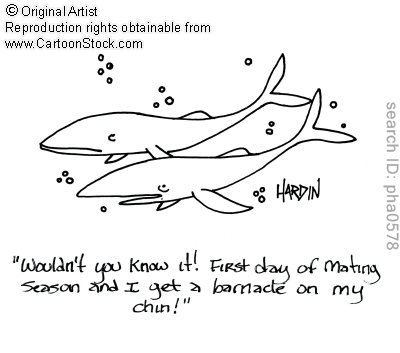

Meetings Meetings
04/10/10 15:55
Sometimes it is difficult to know when meetings are being productive, and when they are just filling the time so that we can justify our paychecks! The last few weeks have been quite full of meetings, individually with students and then with as many as ten colleagues around the table (associated with our Coral EID and Barnacle Biogeography collaborations). As I mentioned in the last update, we’ve been juggling e-conference software as well. Though our EID group has gotten more savvy about using the Adobe Connect Pro meeting software, I’m still by and large very impressed with the EVO system. Not only did it allow more-or-less quality communication among our group of Chileans, New Englanders, and Georgians last week, but it is also quite easy to connect to the same meeting by phone, Skype, or the internet teleconferencing with video/audio. There just really isn’t a good replacement for an occasional face-to-face with colleagues, and then the nitty gritty can get worked out over email.
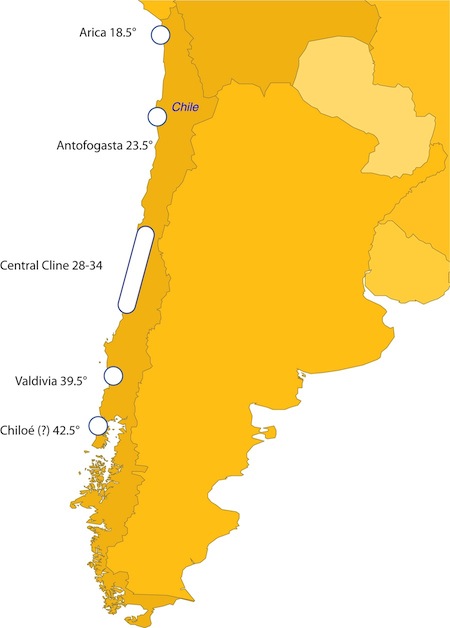
One trade-off involved with working out such details is that in a good collaboration, the workload is appropriately shared so that the best possible science is done most efficiently. In this case, my standing collaboration with Sergio Navarrete has led to a near-perfect situation where his postdoc happens to already be sampling many of the sites that we need samples from in the coming years. This is all going to work out well.... except now I have fewer good excuses for research jaunts to coastal Chile! Clearly, some of our face-to-face meetings will need to be in person, perhaps over a good plate of local seafood and some pisco sours.

One trade-off involved with working out such details is that in a good collaboration, the workload is appropriately shared so that the best possible science is done most efficiently. In this case, my standing collaboration with Sergio Navarrete has led to a near-perfect situation where his postdoc happens to already be sampling many of the sites that we need samples from in the coming years. This is all going to work out well.... except now I have fewer good excuses for research jaunts to coastal Chile! Clearly, some of our face-to-face meetings will need to be in person, perhaps over a good plate of local seafood and some pisco sours.
Communication Breakdown
21/09/10 10:26
While the title of this post stems from Led Zeppelin (but could also be a catchy bluegrass title), it is clear that communication is one of the most important components of science. There are inestimable differences in what can be accomplished in a simple, face-to-face conversation compared to email or even a phone call. So, even though I complain about the travel (see my July 7 post), I know there is good to be had (and not just the beer drinking) in going to meetings.
Some meetings are fun, and a lot of ideas are exchanged – but it never quite translates to getting things done. I’ve gone to a lot of “working group” type meetings, 20-30 people, and it is hard to convey the speed with which ideas loft on hot air (and can be quickly shot down) at such sessions. Sometimes these groups end in synthesis papers, white papers, and such, but it is too easy for us to lose focus once we return to our desks and our full inboxes.
Last week, upon learning that my Chilean colleague Sergio Navarrete was visiting the University of South Carolina, I buckled up and drove 6-7 hours round trip so I could have lunch with him and visit with some of my favorite U.S.-based marine colleagues for a bit as well. Nearly a full day of driving is usually anathema to me, a waste of fuel and hard on my back. But it was extremely productive, even though we spent 2/3 of our time talking about the earthquake that struck Chile in February we sketched out some great ideas for how the field component of our work can begin soon.
I was lucky there - having a necessary and enjoyable colleague within driving distance, and a day when I wasn’t teaching, doesn’t come together often. So now I’m struggling with how to manage my collaborations across the globe most effectively. Our EID work is underway, and we’ve had two meetings using Adobe Connect Pro (to connect the Athens folks with Katie Patterson Sutherland at Rollins College; eventually we’ll pull in more partners to these meetings too). The first meeting went well, and I was impressed with the software. Yesterday - not so well, some echo effects and hiccups in attempting to connect more than 2 laptops, made me a little more concerned.
I think this is going to be fairly important for my OCE funded work in Chile. Two of us are here at UGA, one colleague in New Hampshire, others in Chile. Teleconferencing (either the institutional route, or up to 5 lines on my cell phone) has strange “who has the conch?” problems (and costs associated with long-distance calling; iChat only works on Macs; Skype only allows 2 video feeds. I briefly tinkered with Cisco’s WebEx, which works similarly to Connect Pro, but it seems we are likely to stick with the latter for the EID work so I’d rather know more about one imperfect system than just enough to be dangerous about two such systems.
Hopefully these Voice/Video Over IP solutions are going to be improving. It’s certainly going to be key for us getting things done in the coming years.
update: Ron Eytan, new postdoc in the Wares and Lipp labs, pointed me toward what appears to be an excellent solution. EVO is “worldwide collaboration network” from Cal Tech. I’m not sure how they do it, but the interface is easier, the video is much higher quality than the above solutions, and the audio is no worse....and it is FREE!
Portland
07/07/10 10:15
Just got back from a fantastic trip to Oregon. My lab attended the Evolution meetings in Portland, everybody gave a fantastic talk and we had really good interactions with the swarm of evolution geeks that, like good social organisms, found and followed trails to good brewpubs, restaurants, and other fun things in that beautiful city. Afterward, my family and I had a great time touring the city and heading out to the coast for a few days of R & R.
The only conundrum that remains from great meetings like this - aside from how to respond to all the great ideas that come from talking to so many talented colleagues - is the ugly environmental side of meetings. The organizers in Portland went to lengths to put us somewhere that required no driving, they encouraged bringing reusable cups, and Portland is an extremely green city. But the carbon footprint of flight cannot be ignored. There is no replacement for face-to-face interactions at these meetings; in particular, I’m thinking of some of the extraordinary grad students I talked with over the course of three days about their work and their future plans. But, we can’t ignore the impact of air travel, which sadly negates many of the things we struggle towards with our reusable cups, cycling to work, and unplugging unused appliances. The figure below was taken from a recent story in Mother Jones, and makes me queasy about the 2 flights I’ve already committed to later in 2010, and probably another 1-2 in the next year.
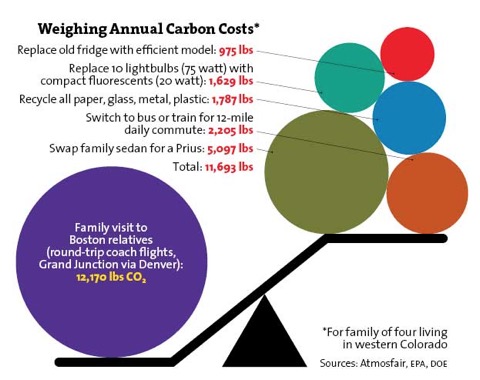
What I am going to do is something that is good for me and my family as well as for the environment. I don’t like being away too much - sometimes it is necessary, but sometimes as scientists we accept invitations to do things that mean little for our work (and more for our egos or careers). If Steve X invites me to give a talk at Fantastic University, it may be flattering and I may gain professionally, but it is not generally critical for my life or my ongoing projects. So, I’m capping myself to 4 air trips a year. That may be tough. I may have to drive to some places I ordinarily would fly to, or figure out Amtrak in the southeastern U.S. (it isn’t good, we are far behind Europe and California in this regard, look at this schedule and price for a trip to Miami!).
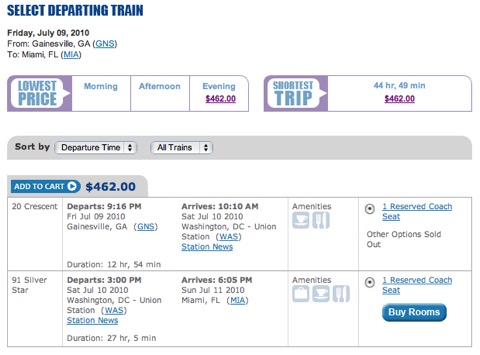
I hope my colleagues understand, but having this excuse is also good for making sure I’m home with my family just a little bit more as well.
The only conundrum that remains from great meetings like this - aside from how to respond to all the great ideas that come from talking to so many talented colleagues - is the ugly environmental side of meetings. The organizers in Portland went to lengths to put us somewhere that required no driving, they encouraged bringing reusable cups, and Portland is an extremely green city. But the carbon footprint of flight cannot be ignored. There is no replacement for face-to-face interactions at these meetings; in particular, I’m thinking of some of the extraordinary grad students I talked with over the course of three days about their work and their future plans. But, we can’t ignore the impact of air travel, which sadly negates many of the things we struggle towards with our reusable cups, cycling to work, and unplugging unused appliances. The figure below was taken from a recent story in Mother Jones, and makes me queasy about the 2 flights I’ve already committed to later in 2010, and probably another 1-2 in the next year.

What I am going to do is something that is good for me and my family as well as for the environment. I don’t like being away too much - sometimes it is necessary, but sometimes as scientists we accept invitations to do things that mean little for our work (and more for our egos or careers). If Steve X invites me to give a talk at Fantastic University, it may be flattering and I may gain professionally, but it is not generally critical for my life or my ongoing projects. So, I’m capping myself to 4 air trips a year. That may be tough. I may have to drive to some places I ordinarily would fly to, or figure out Amtrak in the southeastern U.S. (it isn’t good, we are far behind Europe and California in this regard, look at this schedule and price for a trip to Miami!).

I hope my colleagues understand, but having this excuse is also good for making sure I’m home with my family just a little bit more as well.
Worms
12/05/10 09:16
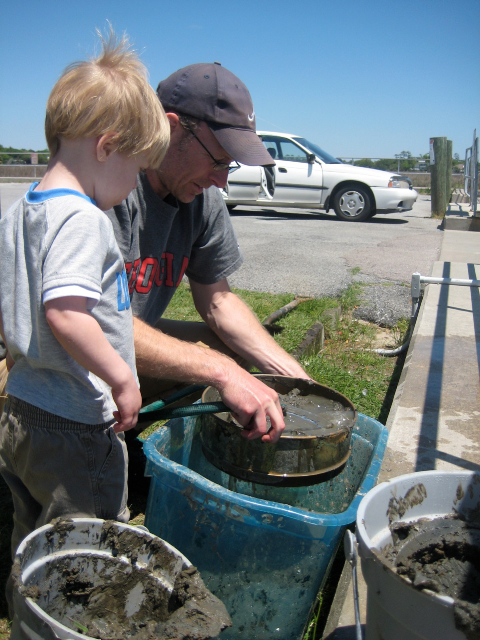
A little proof that I do escape from behind my monitor from time to time. Two weeks ago, I was out at Sapelo Island to visit our Georgia Coastal Ecosystems sites in hopes of finding Streblospio benedicti for my student (Christina Zakas). My field assistant mostly liked to help with the hose and mud. The procedure for finding these critters gives lie to the phrase “find ‘em and grind ‘em” as applied to phylogeography. The problem is that people have come to assume such studies are as simple as driving to an area, scooping up an organism, and then squeezing DNA out of it. Truth is - and its good to be reminded myself when I’m reviewing papers for journals - small sample sizes often result from organisms that are very hard to find, have nasty associated chemistry that inhibits PCR, and/or organisms that are threatened (and thus rare, though we want the data ever so much more).
A week later, I got to touch the Pacific as well. I just got back from an NSF workshop on “Evolution and Climate Change in the Oceans”. Phenomenal group of scientists, very high-level discussion and ideas, a lot of fun - and a good excuse to spend a few days on Santa Catalina Island, off the coast from Los Angeles. My only regret is forgetting to bring running shoes, after several days of travel and meetings I feel pretty sluggish.
Tokyo
16/09/09 15:48
I’m off to Tokyo tomorrow as part of a trip to talk as an invited speaker at the Crustacean Society meeting. Part evolution, part ecology, part physiology, and mostly just a lot of love for these beautiful creatures!
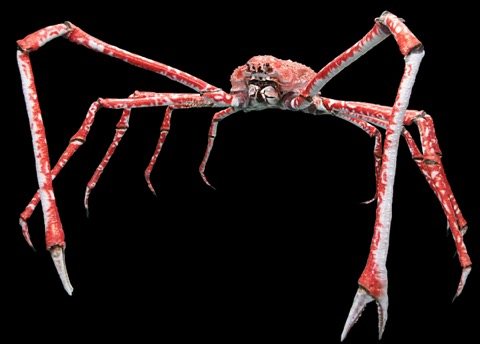
I’ve wrapped up two manuscript revisions in the past 2 days, written a lot of verbiage for 3 grant proposals, and done so without much sleep thanks to the flu ravaging my household (having a toddler who drools a lot can’t help). But so these things are, for the time being, DONE. Meaning I can leave and actually turn my machine off. That’s when I noticed how long my Mac Pro had been up, problem-free: 85 days. As long as I’ve owned it. No crashes, at least 3 genome assemblies, web interactions, thousands of emails. We’ve come a long way from the beasts I had to restart several times a day during grad school.

I’ve wrapped up two manuscript revisions in the past 2 days, written a lot of verbiage for 3 grant proposals, and done so without much sleep thanks to the flu ravaging my household (having a toddler who drools a lot can’t help). But so these things are, for the time being, DONE. Meaning I can leave and actually turn my machine off. That’s when I noticed how long my Mac Pro had been up, problem-free: 85 days. As long as I’ve owned it. No crashes, at least 3 genome assemblies, web interactions, thousands of emails. We’ve come a long way from the beasts I had to restart several times a day during grad school.